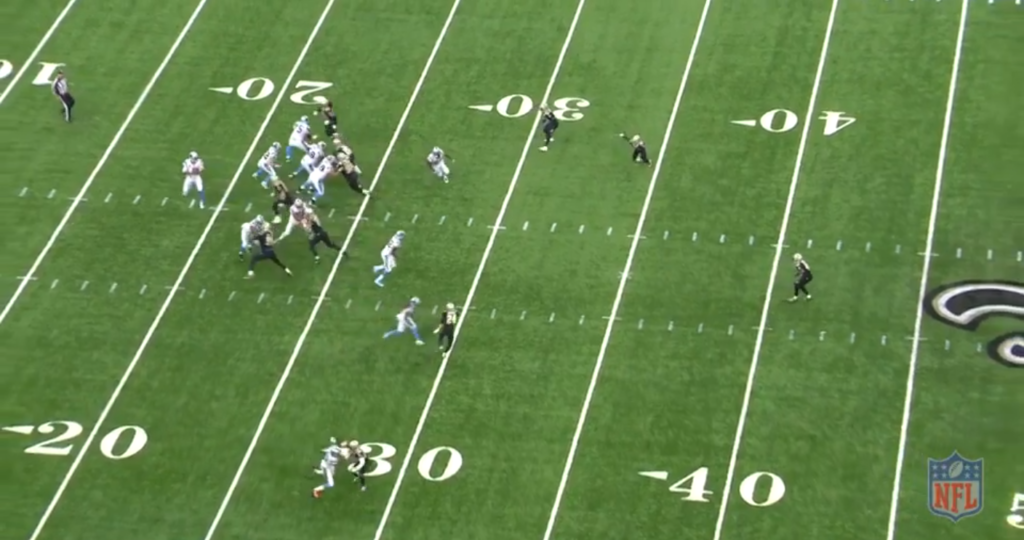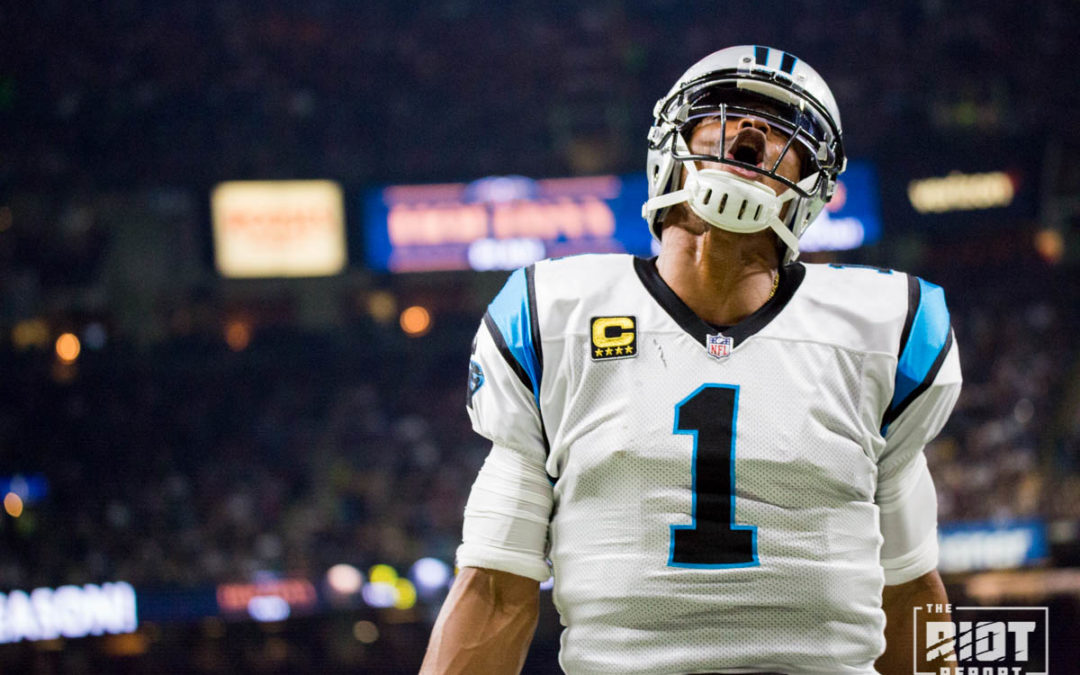Despite the Panthers failing to win the game in New Orleans, Cam Newton actually played very well on Sunday. Given this, what prevented the Panthers from being more effective on offense against the Saints? While some of the offense’s failings in the passing game were due to mistakes by Cam, it is also important to examine how the surrounding players and coaches didn’t put Cam in a position to succeed and how sometimes, it just isn’t your day.
If It Wasn’t For Bad Luck…
As a quarterback, Cam Newton has an immense amount of control over how the offense performs. With that being said, there are still things which lie out of his control; and to a reasonable extent out of the control of the Panthers. An example of this is batted passes. While teams do practice avoiding defenders looking to bat balls at the line; for the most part, it lies out of anyone’s control. Every quarterback has passes batted down at the line; given that, the following two plays can almost be ascribed to the cost of doing business.
What is harder to swallow is when things go against you that are completely avoidable but also out of your control. The ‘no call’ on the false start early in the third quarter is an unjustifiably bad piece of refereeing and something that should have led to a first down.
All of these plays are out of the Panthers’ control, and in themselves didn’t change the game in an irreparable way; but the role of ‘luck’ in the NFL shouldn’t be disregarded.
Some Of It’s On Cam
As good as Cam was against the Saints, it would be foolish to claim that he was perfect on every snap. On two plays, Newton made mistakes that an elite starting quarterback in the NFL, something Newton most certainly is, shouldn’t be making.
This is not a particularly well-designed play; the Saints clearly don’t buy the run fake and there is nobody open for Newton down the field. With that being said, Newton needs to recognize this earlier and dump the ball down to Stewart and look to limit his losses. He certainly needs to be smarter than to take a completely unnecessary sack.
This play is another which Newton should probably make; once the linebacker blitzes, Newton needs to recognize the lack of underneath coverage and hit Clay on the crossing route. Neither of these plays are especially grievous, but a player of Newton’s quality should be expected to make them. The following two plays, however, are ones which Newton is at least partially to blame for, but for which he was put in a very tough situation.
At full game speed, it is clear that the linebacker gets home very quickly and Newton has very limited time to make the read. With that being said, Newton should have recognized the likely blitz before the snap and realize that is where the initial read should be, with the option to work up the field should the linebackers drop into coverage. Yes, McCaffrey might well have made a mistake in not chipping Klein, but the following image suggests that even with the free rusher Newton had a decent chance to hit Dickson for the first down.

Another play where Cam potentially made an error was on the failed fourth down conversion down 28-14 in the final quarter. It looks as though Cam pre-determined where he was going to go with the ball without looking to any other receiver. Had Cam looked to read the defense more post-snap he would have noticed the all-out blitz opening up the middle for a potential completion to Shepard. Teams are not meant to convert on red zone fourth-and-sixes with any regularity and so blaming the stagnation of the drive on Cam would be foolish, but the fact remains that he could possibly have made a better decision on this play.
The final play that was potentially on Cam was the stuffed shovel to McCaffrey.
The Saints are in a cover-zero defense, with no high safety. Newton needs to recognize this pre-snap and audible to a play which looks to get the ball deep. If Cam was unable to audible out of the play, then that warrants more questions about the coaching, but on the assumption that Cam could have audibled out of it, he really should have.
Dropping The Ball
At the end of the day, if the quarterback does everything right, they still rely on the receiver to catch the ball that’s thrown their way. On at least two plays against the Saints, Cam put the ball on the money only for it to be dropped. While the pass to Manhertz on the first drive would have been a difficult catch and didn’t kill the drive, it could well be considered a third.
Shepard has struggled with drops this year, and the above play is one of the less egregious examples of that; this isn’t an easy catch but Shepard probably should have made it. The next play is simply a lapse in concentration by Funchess and could have prevented the Panthers from having to go for it on fourth down.
These drops are absolutely not on Cam, and certainly didn’t help the Panthers against the Saints. With that being said, they were not the only errors made by the surrounding cast.
We Need To Talk About Blocking
A lot has been made about the Panthers’ pass protection against the Saints, most notably by Matt Kalil. With that being said, the blocking errors went beyond the offensive line. On the following play, Funchess just completely whiffs on the block leading to an easy tackle for a loss.
If Funchess makes his block, then McCaffrey would likely have had a decent chance of picking up a big play. What was probably a bigger issue for the Panthers against the Saints was the use of running backs in pass protection.
While Newton should probably been able to spot the open man despite this, initially keeping McCaffrey on the above play is completely ineffective. Whether this is a mental error by McCaffrey or a failure to communicate the protection is unclear, but leaving the blitzer completely unblocked while keeping the running back in certainly doesn’t help Cam.
While that play could certainly be placed on player error, the following play seems flawed in its design.
Asking a running back to block a defensive end in pass protection on a deep pass is optimistic at best and farcical at worst. If Cam is able to step into this throw, this would likely have been a touchdown; something that was taken away by the unnecessarily risky protection scheme.
Designed To Fail
Cam Newton has hidden a lot of flaws in the Panthers’ offense over the years, but there are times when the play design puts him in positions where he is bound to fail. The most common example of this is the use of max protection plays; on plays such as the following where the Panthers keep an additional blocker in, they are simply giving a mathematical edge to the defense. While they do give Cam slightly more time to make the throw, they allow the Saints to use seven defenders to cover the four receivers.
It probably shouldn’t be a surprise that Newton has nowhere to go with the ball. This then forces him to hold onto it and allows the Saints more time to get to Newton. Ironically, by keeping an extra player in to block, the Panthers make it easier for the Saints to get to Newton.
Even on the plays where the Saints do blitz, they have a distinct numbers advantage against the Panthers’ receivers and the extra blockers do little to nothing to help in pass protection. The Panthers would do far better to use McCaffrey and Manhertz on hot routes to get the ball out quickly should the Saints blitz. Given how McCaffrey has fared in pass protection and how impressive he has been as a receiver; any time he is used in pass protection should lead to significant questions about the offensive game plan.
Another concern going into the season was how the Panthers would use five receiver sets. On the following play the Panthers use four receivers on zone-beating routes with one receiver looking to force the safety deep; the only issue being that the Saints are in man coverage.
The odds of a fourth zone beater being needed are effectively zero; the odds of a quarterback misdiagnosing man and zone are much, much higher. By designing plays like this, the Panthers’ coaches are effectively going all-in with little to no reward should the play succeed.
The coverage the Saints are running here is probably the hardest to attack in football with the weakness being outside-breaking man-beaters. With that being said, McCaffrey has had great success on such routes and running something such as a smash concept with him and Funchess would have allowed the Panthers to attack both man and zone rather than fully-committing against zone.
None of these areas led to the Panthers’ loss on their own; special teams and defense had a significant part to say the least, but many of these are relatively easy to fix and could help the Panthers be far more consistent on offense, rather than leaving everything to Cam’s brilliance on a weekly basis.



